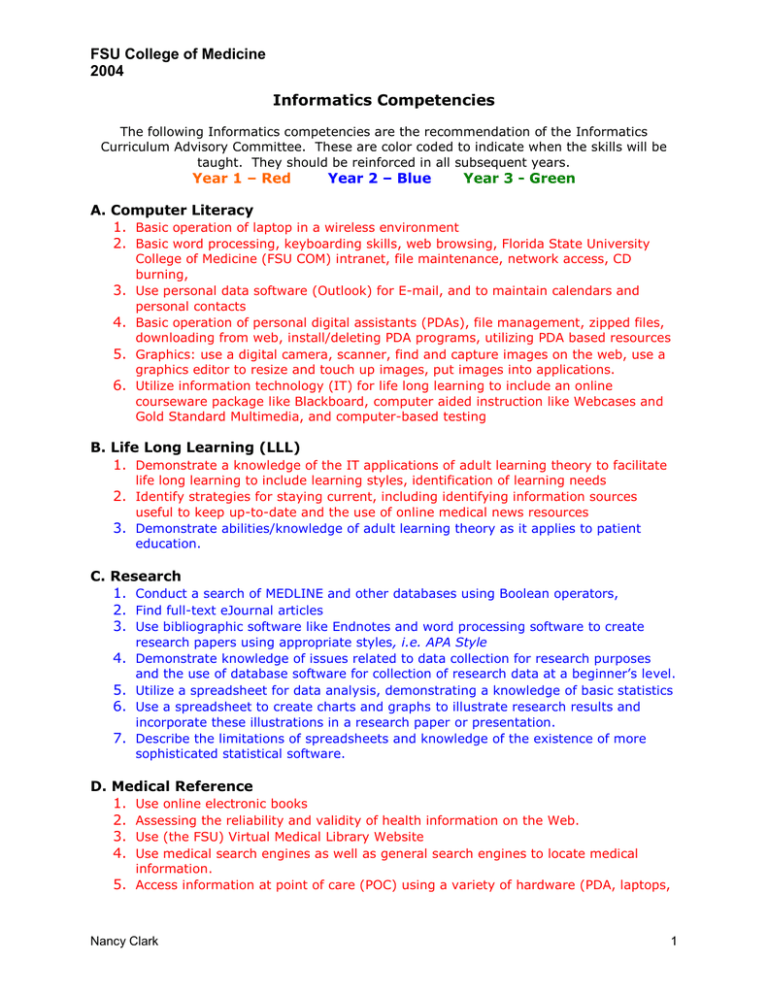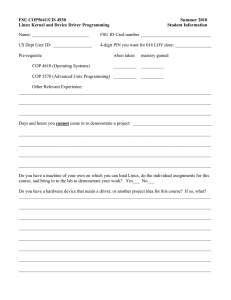FSU College of Medicine 2004 Informatics Competencies
advertisement

FSU College of Medicine 2004 Informatics Competencies The following Informatics competencies are the recommendation of the Informatics Curriculum Advisory Committee. These are color coded to indicate when the skills will be taught. They should be reinforced in all subsequent years. Year 1 – Red Year 2 – Blue Year 3 - Green A. Computer Literacy 1. Basic operation of laptop in a wireless environment 2. Basic word processing, keyboarding skills, web browsing, Florida State University 3. 4. 5. 6. College of Medicine (FSU COM) intranet, file maintenance, network access, CD burning, Use personal data software (Outlook) for E-mail, and to maintain calendars and personal contacts Basic operation of personal digital assistants (PDAs), file management, zipped files, downloading from web, install/deleting PDA programs, utilizing PDA based resources Graphics: use a digital camera, scanner, find and capture images on the web, use a graphics editor to resize and touch up images, put images into applications. Utilize information technology (IT) for life long learning to include an online courseware package like Blackboard, computer aided instruction like Webcases and Gold Standard Multimedia, and computer-based testing B. Life Long Learning (LLL) 1. Demonstrate a knowledge of the IT applications of adult learning theory to facilitate life long learning to include learning styles, identification of learning needs 2. Identify strategies for staying current, including identifying information sources useful to keep up-to-date and the use of online medical news resources 3. Demonstrate abilities/knowledge of adult learning theory as it applies to patient education. C. Research 1. Conduct a search of MEDLINE and other databases using Boolean operators, 2. Find full-text eJournal articles 3. Use bibliographic software like Endnotes and word processing software to create 4. 5. 6. 7. research papers using appropriate styles, i.e. APA Style Demonstrate knowledge of issues related to data collection for research purposes and the use of database software for collection of research data at a beginner’s level. Utilize a spreadsheet for data analysis, demonstrating a knowledge of basic statistics Use a spreadsheet to create charts and graphs to illustrate research results and incorporate these illustrations in a research paper or presentation. Describe the limitations of spreadsheets and knowledge of the existence of more sophisticated statistical software. D. Medical Reference 1. Use online electronic books 2. Assessing the reliability and validity of health information on the Web. 3. Use (the FSU) Virtual Medical Library Website 4. Use medical search engines as well as general search engines to locate medical information. 5. Access information at point of care (POC) using a variety of hardware (PDA, laptops, Nancy Clark 1 FSU College of Medicine 2004 desktops, tablet PCs), 6. Use highly-referenced, decision support sites: such as DxPlain, Dynamed, drug references, treatment guidelines, and prevention resources 7. Demonstrate knowledge of copyright and intellectual property issues surrounding the use of online resources. Accurately cite the source of all copyrighted resources used in papers and presentations. E. Communication 1. Demonstrate professional presentation skills 2. Demonstrate the use of software to support professional presentations such as PowerPoint 3. Demonstrate the ability to produce appropriate handouts for professional 4. 5. 6. 7. 8. presentations using a variety of applications Demonstrate knowledge of issues related to the appropriateness of printed patient education materials Locate appropriate patient education resources, use word processing software to assess reading level, modify, translate, and saving for future use. Demonstrate knowledge of the uses of telemedicine Utilize video conferencing effectively Demonstrate knowledge of the issues surrounding the patient-doctor-computer triad: and the effects of IT on the doctor/patient relationship F. Clinical Information Management 1. Systematically and reliably document all patient encounters at FSU COM in the CDCS System 2. Demonstrate knowledge of issues surrounding the privacy and security of clinical 3. 4. 5. 6. 7. 8. 9. data, including Health Insurance Portability and Accountability Act (HIPAA), confidentiality, E-Mail with patients and colleagues (operation, netiquette, and issues); and use of discussion lists, blogs, etc. Document an outpatient clinical encounter in SOAP and POMR format and appropriate inpatient progress notes Identify problems and circumstances that should have a flow sheet in a medical record, the variables that should be included and the frequency with which they should be followed, including health maintenance and disease management flow sheets. Demonstrate knowledge of the uses of IT to improve patient outcomes and patient safety: i.e. combining decision support, patient information and communications technologies in systems like computerized physician order entry systems (CPOEs). Demonstrate knowledge of the value of electronic clinical information systems (EMRs, etc.) to a medical practice and the community both in terms of cost efficiency and in improvements in patient outcomes and safety. Demonstrate knowledge of current local, regional and national initiatives in healthcare IT to integrate clinical information systems, such as regional health information organizations (RHIOs), that share patient information to promote patient safety, coordinate care for chronic disease management, and reduce healthcare costs. Access patient medical information electronically using an electronic medical record (EMR) Maintain a complete and accurate patient medical record appropriate for clerkship, identifying the parts of the record to include problems list, medication list, allergies, health maintenance, PMH, FH, SH, appropriate flow sheets, lab and imaging findings. Nancy Clark 2 FSU College of Medicine 2004 10.Demonstrate knowledge of coding of medical data: ICD, CPT, E&M, and standards for clinical data structure such as HL7 and the Continuity of Care medical record format. 11.Demonstrate knowledge of the uses of healthcare information system applications such as billing systems, appointment systems, EMRs, CPOEs, and integrated healthcare information systems. G. Evidence Based Medicine (EBM)-Epidemiology: 1. Demonstrate skill and the use of information technology to apply principles of 2. 3. 4. 5. epidemiology learned in health policy, identifying online resources which contain medical statistical data sets. Formulate a clinical question, identify the type of question, identify the type of research that would answer that type of question, then search the primary literature for evidence-based information using evidence-based search filters, and search EBM databases such as the Cochrane Library and InfoRetriever for digested forms of relevant evidence. Apply EBM criteria to determine the level of evidence of information resources based on CEBM criteria. Demonstrate the ability to critically review the medical literature applying levels of evidence to the decision making process. Locate and utilize clinical practice guidelines in the clinical decision making process. Nancy Clark 3

